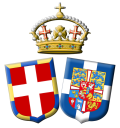The topic of this article may not meet Wikipedia's general notability guideline .(October 2025) |
The Duchess of Aosta is the wife of the Duke of Aosta, a title created by Frederick II, Holy Roman Emperor in the 13th century. The Duchy of Aosta had already been ruled by the House of Savoy for some time; it is a corner of the Italian Alps now bordering France and Switzerland, essentially the same as the Aosta Valley. The title of duke tended to be given to the second son of the ruler, reverting to the head of the house, until Amadeo I of Spain (1845 – 1890), the first and only King of Spain from the House of Savoy. He was the second son of King Vittorio Emanuele II of Italy and was known for most of his life as the Duke of Aosta. He was elected by the Spanish parliament (the Cortes) as King of Spain in 1870, but abdicated in 1873. He created a new Aosta branch of the House of Savoy, which retains the title, although it is not legally recognised.
The duchesses have in recent centuries been royal or princely. In 2021 the duchess was Princess Olga of Greece, younger daughter of Prince Michael of Greece and Denmark.[ citation needed ]
| Picture | Name | Arms | Father | Birth | Marriage | Became Duchess | Ceased to be Duchess | Death | Spouse |
|---|---|---|---|---|---|---|---|---|---|
 | Maria Theresa of Austria-Este | Archduke Ferdinand of Austria-Este (Austria-Este) | 1 November 1773 | 21 April 1789 | 4 June 1802 became Queen of Sardinia | 29 March 1832 | Vittorio Emanuele | ||
 | Maria Vittoria dal Pozzo della Cisterna | Charles Emmanuel dal Pozzo della Cisterna (dal Pozzo della Cisterna) | 9 August 1847 | 30 May 1863 | 8 November 1876 | Amedeo I | |||
 | Maria Letizia Bonaparte | Prince Napoléon Bonaparte (Bonaparte) | 20 November 1866 | 11 September 1888 | 18 January 1890 husband's death | 25 October 1926 | |||
 | Hélène of Orléans | Philippe, Count of Paris (Orléans) | 13 June 1871 | 25 June 1895 | 4 July 1931 husband's death | 21 January 1951 | Emanuele Filiberto | ||
 | Anne of Orléans | Jean, Duke of Guise (Orléans) | 5 August 1906 | 5 November 1927 | 4 July 1931 husband's accession | 3 March 1942 husband's death | 19 March 1986 | Amedeo | |
 | Irene of Greece and Denmark |  | Constantine I of Greece (Schleswig-Holstein-Sonderburg-Glücksburg) | 13 February 1904 | 1 July 1939 | 3 March 1942 husband's accession | 29 January 1948 husband's death | 15 April 1974 | Aimone |
 | Claude of Orléans | Henri, Count of Paris (Orléans) | 11 December 1943 | 22 July 1964 | 8 January 1987 marriage annulled | living | Amedeo | ||
| Silvia Paternò di Spedalotto | Vincenzo Paternò di Spedalotto, 6th Marchese di Regiovanni (Paternò di Spedalotto) | 31 December 1953 | 30 March 1987 | 1 June 2021 husband's death | living | ||||
 | Olga of Greece |  | Prince Michael of Greece and Denmark (Schleswig-Holstein-Sonderburg-Glücksburg) | 17 November 1971 | 27 September 2008 | 1 June 2021 husband's accession | living | living | Aimone |